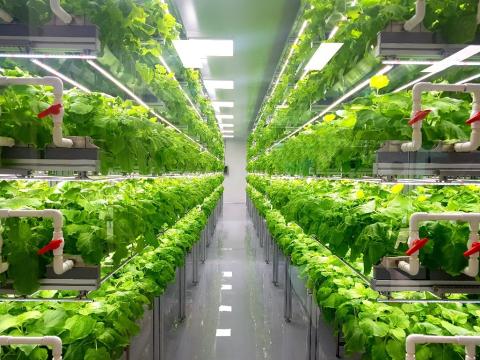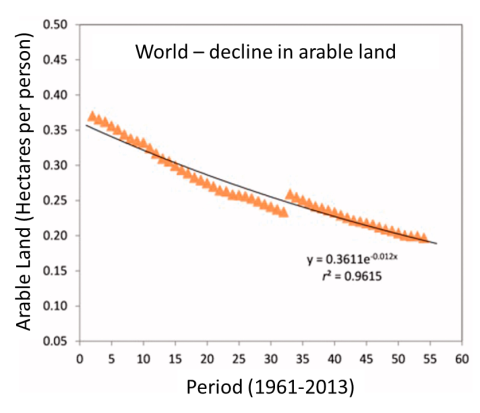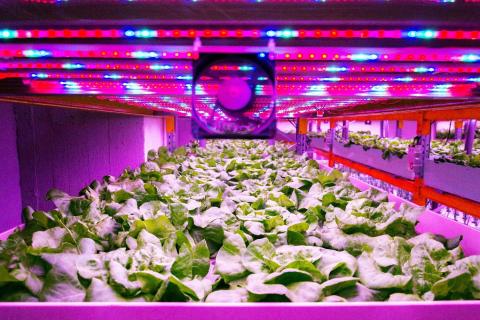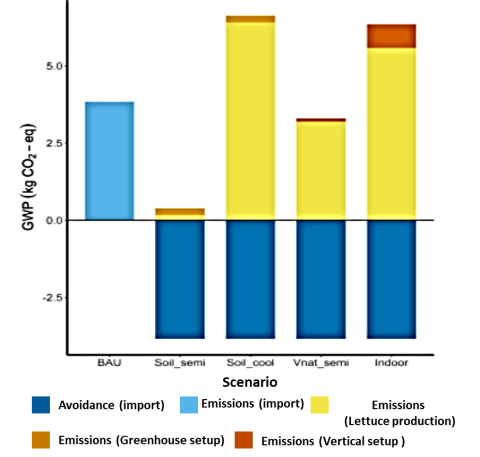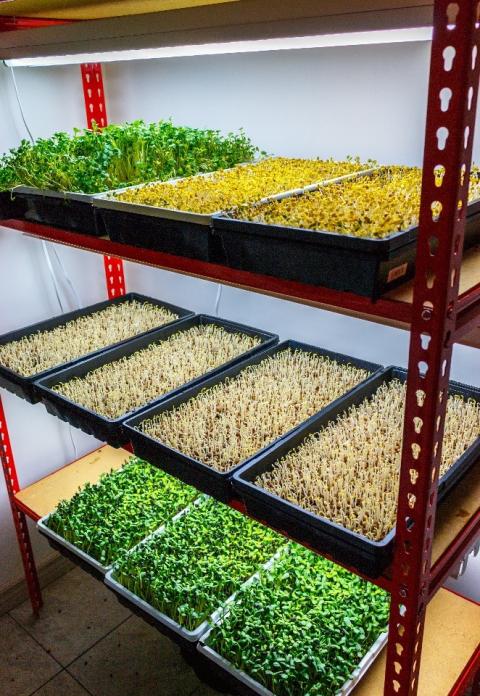9 February 2022
Dr David Cutress: IBERS, Aberystwyth University.
- Controlled environment agriculture (CEA) may have an increasing interest as our available land for traditional growth strategies diminishes
- Extreme weather that impacts outdoor crops also adds benefits to CEA alternatives
- CEA allows full control of growth conditions at the cost of higher energy use
- Climate impact per product output is better in many CEA systems compared to traditional ones but improvements in energy efficiencies would increase this further
The appeal
Agriculture globally is noted to be responsible for about a third of all greenhouse gas (GHG) emissions, for this reason as a sector it is looking towards options that could mitigate current and future impacts. Controlled environment agriculture (CEA) is an area, which its advocates suggest, has the potential for reducing emissions. CEA in its most common forms is inclusive of greenhouses, rooftop enclosed gardens, vertical farms (VF) and plant factories (PF). As well as proposed direct climate impacts associated with CEA external factors for moving to such systems include land increasingly being prioritised for other purposes. There is an increasing need for more housing for an ever-growing population as well as a shift of landscape use for specific carbon mitigation strategies such as forestry and biofuels.
Taken from Benke and Tomkins 2017
The appeals of a CEA system include the ability to have full control over the environment which allows for optimal growth conditions to be provided towards maximising yield and achieving year-round productivity. This can also help to prevent impacts associated with climate conditions, which occur in outdoor scenarios, as these can reduce or eliminate harvests. Furthermore, controlled systems can allow for more accurate dosage, control and circularity in the nutrients and water supplied whilst also protecting crops from opportunistic pests and diseases. Figures suggest that 70% of the current indoor farming market is dominated by greenhouses as such these should be a core consideration for the analysis of CEA as a whole and particularly when deducing climate impacts of CEA. It was, however, noted in 2018 that most of the current scientific publications focus heavily on VF suggesting this may be the more significant growth area of CEA moving forwards. But this article is here to ask; do we know how efficient and sustainable most CEA practices are?
CEA and efficiency
Currently, where CEA is discussed, it is often perceived as an energy-intensive system due to its reliance on powered artificial lighting and irrigation systems. A key finding of a thesis produced in Harvard University found that despite CEA systems’ high energy-intensive nature, the efficiency of such growing spaces to produce increasing yields with the same land and energy inputs (such as via increased vertical stacking) in CEA means that yield gains increase at a higher rate than energy usage does. This suggests that at certain levels of production CEA should outperform traditional agriculture in a kg of carbon dioxide equivalent (CO2e) per kg of product scenario. One of the main energy efficiency factors of indoor systems is heating and humidity which are controlled generally via heating ventilation and air conditioning (HVAC) units which have inherent energy demands. In extremely cold climates, these can account for >70% of all operational costs and in warmer climates up to 50% of costs. The importance of temperature and humidity control are often related to the vapour pressure deficit (VPD).
Between CEA systems some studies have been performed which compared greenhouses and PF systems across four climates in the US and consistently found greenhouses performed better for energy consumption and carbon footprint. Alternatively, a study in 2018 of the same two CEA system types found that in climates of the Netherlands, the United Arab Emirates and Sweden PF systems outperformed greenhouses. This is just a small indication that the modelling of impacts can be variable based on climate and specific technologies implemented in each system. Energy-efficient measures (EEMs) have a huge role to play in how impactful on the climate a system will be overall. Whilst it is clear there are certain studies on efficiency in CEA (see table below) it was noted as recently as 2021 that there is a significant lack of comprehensive comparative data available, looking between different CEA systems with regards to efficiencies. This is a barrier towards our full understanding of knock-on climate impacts which needs to be addressed as the sector moves forwards. One study, which has sought to address this specifically, compared open and closed greenhouses to indoor PF systems and found that in most inhabitable regions (regions being important due to the impact of the surrounding climate and environmental conditions) high-tech ventilated greenhouses outperformed PFs with regards to energy efficiency.
Table of CEA efficiencies in comparison to traditional equivalent outdoor growth scenarios
|
System |
Output |
Water use |
Land use |
Energy use |
CO2 emissions assocaited |
Reference |
|
VF |
~x2 higher |
70-90% less |
N/A |
N/A |
N/A |
|
|
VF (Plenty Unlimited INC) |
≥x350 higher |
almost x100 less land |
N/A |
N/A |
||
|
Rooftop garden |
x10 higher |
N/A |
x10 less land |
£2.26 energy use a month per 9-meter tower |
N/A |
|
|
VF/PF underground |
up to 5000 heads of lettuce a day |
N/A |
N/A |
3x more efficient |
N/A |
|
|
CEA system (microgreens) |
42% less mass of microgreens has same minerals as mature plants |
158 - 235 x less |
N/A |
If grown and consumed locally eliminates storage and transport excessive energy use |
N/A |
|
|
Hydroponic Greenhouse |
~10 x higher |
~80% less |
~10 less land |
≥200 x higher energy |
188 kg CO2 per ton of lettuce less |
|
|
VF |
≥20 x higher |
99% less |
~300x less land |
≥250 x higher energy |
382 kg CO2 per ton of lettuce less |
Energy efficiency measures (EEMs)
There are clear areas where most of the energy inefficiencies lie within CEA systems. As such focusing on research and technologies to address these areas can have a huge impact in improving the climate impacts of the systems as a whole and encouraging further adoption of CEA as a strategy.
Temperature
The replacement of standard heat pump systems in CEA with co-generation equipment facilitates the energy input producing heat or cold whilst inherently also producing electricity to offset some of the energy demand or/as well as possibly CO2 which can be provided to the plants to boost growth. An interesting innovation in Japan involves the design of underground facilities in previously abandoned tunnels where constant temperatures are maintained between 18-20°C year-round eliminating much of the heating and cooling energy considerations of a standard CEA system. Insulation, shading/cover, building orientation and materials utilised in construction all also have impacts on the internal temperature stability and energy efficiency in maintaining optimal conditions.
Humidity/Transpiration
Largely many of the EEMs noted above for temperature will have knock-on benefits or considerations for humidity levels. HVAC automation systems linked to smart ventilation or fogging systems for example may play key roles here. Equally systems of modelling have been developed which can assist growers in relaxing the temperature and humidity boundaries within their integrated indoor control system to make huge energy savings whilst minimally impacting crop productivity levels.
Lighting/photoperiod manipulation
Lighting measures largely relate to advances in efficient LED systems, but more information on this can be found here. Generally speaking, the use of the correct LED systems could reduce maintenance and costs by increasing bulb lifespans up to two times if not more and has been predicted (due to theoretically up to 4 – 5 times higher energy to light transformation efficiencies) to result in 47% energy savings compared to traditional lighting systems. This is the area of biggest concern as typically lighting has been seen to be the highest use of electricity in many systems.
Whilst difficult to quantify with regards to impact on climate factors and energy efficiencies overall, labour is another area where CEA systems can improve EEMs. CEA operations are generally far more adaptable to automation via robotics and other machinery, meaning that huge production rates can be achieved with minimal labour inputs. Whilst machines themselves add to the inherent energy inputs, the reduction of energy inputs associated with labour such as fuel for commuting could make this more favourable. Furthermore, reduced labour reduces production costs leading to better energy efficiency and CO2e figures when compared to profit margins.
Finally, another possible EEM is the incorporation of aquaponics, which if optimised could improve energy efficiencies by improving the circularity of nutrient flows and reducing nutrient input requirements. For more information on this see our previous article. Of note from this article (see table 2), many current hydroponic systems offer far better climate impact in the form of lower global warming potentials (GWP) than the aquaponics systems assessed. This does not mean this strategy won’t after further research and optimisation, play a future role in CEA systems.
CEA and climate impacts
The main outcome associated with climate impacts of CEA compared to traditional systems is, currently, not necessarily one where gains are found. Instead, CEA systems tend to lead to a shift in where this impact occurs. CEA systems reduce impacts associated with environmental pollution and they utilise water, space, transportation and nutrients far more efficiently. The cost of these benefits comes at the price of far higher energy consumptions to power irrigation, lighting and environmental control systems. As such where CEA can be linked with technologies that improve efficiencies (for example by using by-product waste heat from already established industrial systems) or can utilise energy from renewable sources (wind, solar, geothermal etc.), then it has a far more sustainable future compared to conventional growing methods. This was highlighted in a study where it was shown that GHG emissions associated with PFs can be reduced by 60% via the incorporation of such innovations.
Transportation impacts are another key area of CEA impacts. Generally, these are variable depending on specific food processing chains, however, based on DEFRA figures, in the UK, 25% of all miles covered by heavy goods vehicles (HGVs) is food-related, with CO2 annual outputs of 19 million tonnes. These figures globally can be more significant depending on the complexity of the supply chain of each country, with aggregate transportation (including travelling to supermarkets etc) accounting for over 10% CO2 emissions of food production in one US study. CEA can more easily address emission impacts of transport as construction can be targeted for urban areas and utilise strategic logistical analysis tools to minimise transportation requirements countrywide. The impact of this was shown in a study of lettuce growth in the US where increases in GWP due to higher energy demands in CEA systems were almost entirely mitigated by placing CEA growth locations very near to the required delivery locations.
A Study looking at achieving self-sufficiency in leafy vegetables in Singapore compared growth between indoor vertical farming and indoor vertical farming inclusive of natural light (Vnat), business as usual (BAU) traditional soil farming with import and semi enclosed greenhouses with soil growth medium. The study found that Vnat growth was most beneficial in all aspects other than water use and was slightly outperformed by soil growth in greenhouses with regards to CO2e emission balances (see figure below). This is further evidence that if the emissions associated with CEA systems can be mitigated via EEMs, in this case the EEM being the inclusion of natural light in the Vnat system vs the Indoor system, then the balance of sustainability could shift towards CEA systems.
Rooftops gardens are an area proposed to have knock-on impacts on the building infrastructure energy and emission use on which they are situated. Due to their greening impact, these systems can reduce both the building heating and cooling loads at different times of the year leading to energy savings in internal climate control. Another interesting utilisation of CEA for improved sustainability has concerns utilising energy more circularly in cities for example by using the waste heat from rooftop greenhouses to heat residential dwellings. Furthermore, warming global conditions are likely to
cause increasingly unpredictable climatic weather impacts which will inherently lead to variability in food production outputs in outdoor scenarios. We have seen significant shifts in harvests in the past 5 – 10 years due to heavy flood and drought conditions which arable farmers have been unable to deal with efficiently. CEA systems largely prevent these climate change-related factors from having any bearing on the productivity of a supply chain. The only alternative option to this may lie in targeted breeding of hardier crops or genetic modification.
Other options for improving the climate impacts of CEA systems may lie in the choice of crops utilised. An interesting option where this is concerned is the growth of micro-greens and sprouts as the production of such crops requires minimal energy inputs for a very quick turnaround of products that can have relatively high sale prices. It was noted using broccoli microgreens that 158 - 236 times less water was needed and 93 - 95% less time was required to grow products with the same nutritional value as from mature plants outdoors (with subsequent gains through lack of fertiliser and pesticides required). By focusing on CO2e kg per £ product or per nutritional benefits, microgreens and sprouts would likely give very favourable results.
Summary
Evaluation of the climate impact of CEA systems can be extremely difficult as there is a complex array of direct and indirect effects involved. Much scientific research relies on studying a single aspect/system or a handful of these at a time either in comparison to traditional equivalents or more rarely in comparisons between CEA systems themselves. Whilst much research demonstrates the potential for CEA systems to utilise strategies and technologies to be far more energy-efficient, more research and development with energy efficiency at the forefront is actively ongoing and is still required. Reducing energy requirements of CEA systems is not only vital for climate impacts but also for the profitability of the industry itself as such it is likely to be an area that sees increasing focus and advances shortly. For CEA to be most effective it needs to utilise stacking, as this is the easiest method to improve product output in the same space with very similar energy requirements and should be linked to renewable energy sources to supply its higher energy demands.
If you would like a PDF version of the article, please contact heledd.george@menterabusnes.co.uk

